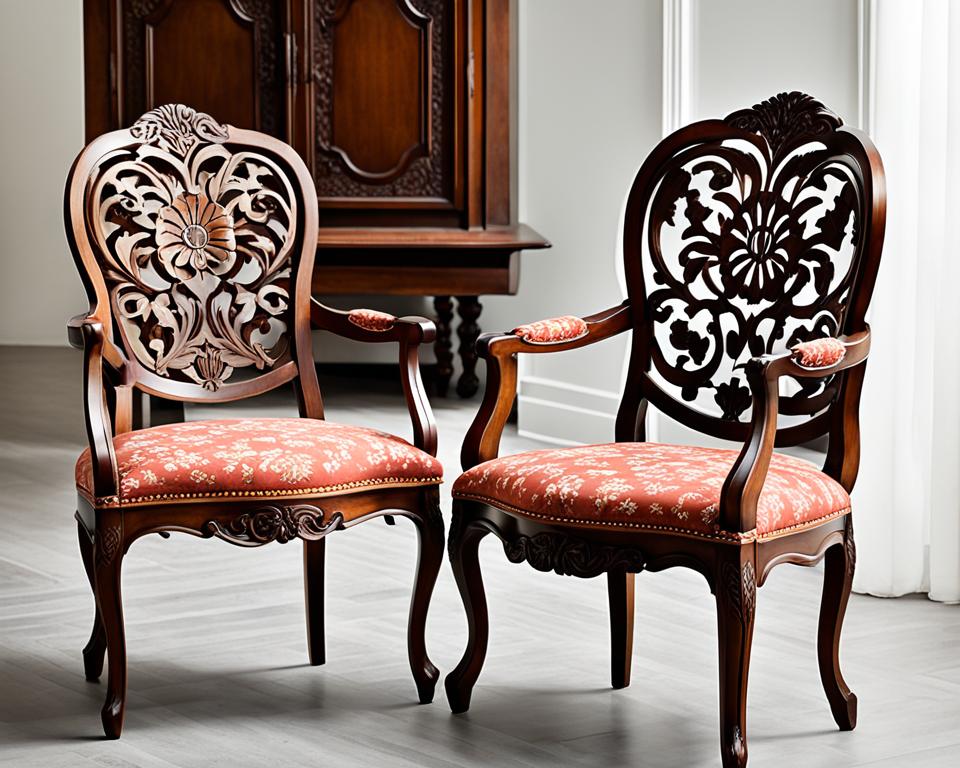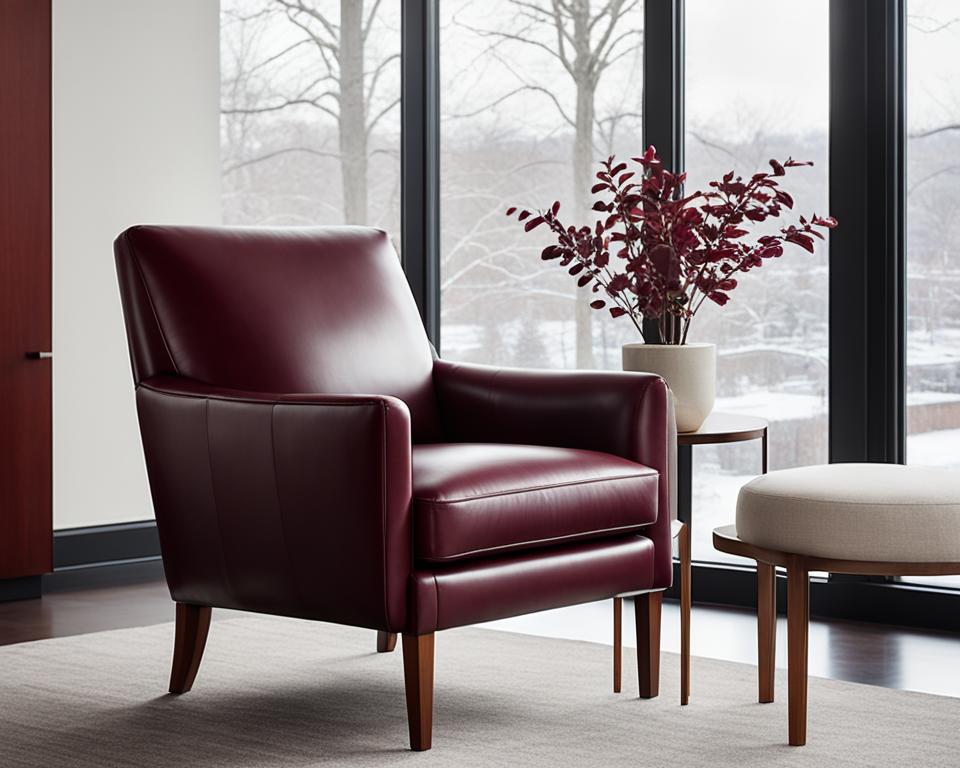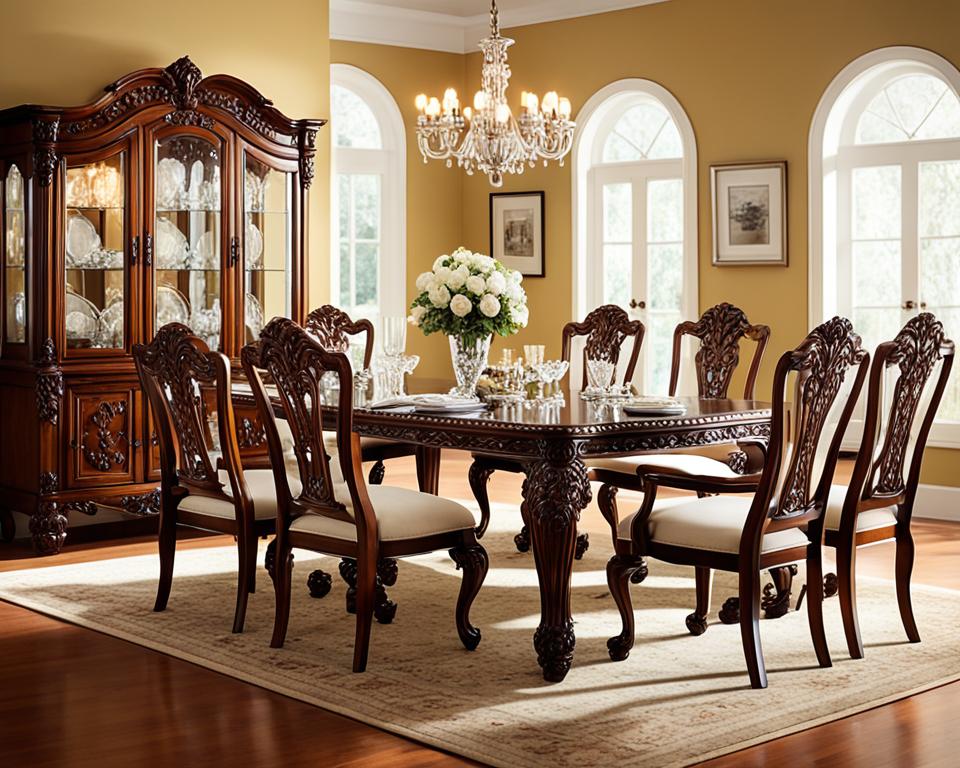
American Colonial Furniture encompasses a wide range of vintage and antique furniture styles that were prevalent in the United States from about 1650 to 1850. These furniture pieces reflect the colonial style and historic charm that has remained popular throughout the years. From traditional designs to authentic colonial furniture, they offer a glimpse into the rich history and timeless elegance of American craftsmanship.
Key Takeaways:
- American Colonial Furniture includes a variety of vintage and antique pieces from the 17th to 19th centuries.
- The furniture styles were influenced by English designs with slight variations.
- These furniture pieces are known for their simplicity in form and decoration.
- Joinery techniques, carving, and turning were common decorative elements in early American furniture.
- Regional characteristics and influences can be seen in the designs of American colonial furniture.
Early American Furniture in the Index of American Design
The Index of American Design is a comprehensive compilation of the major styles of fine American furniture from 1650 to 1850. This invaluable resource provides insight into the rich history and craftsmanship of colonial furniture. From the 17th-century Jacobean-style chests and wainscot chairs to the 18th and 19th-century slat-back chairs and Windsor chairs, the Index of American Design offers a fascinating glimpse into the evolution of American furniture.
To appreciate the diversity and enduring appeal of American colonial furniture, it’s essential to explore the different styles that emerged during this period. The following table highlights some of the iconic furniture pieces that were popular during the 17th, 18th, and 19th centuries:
| Century | Furniture Style |
|---|---|
| 17th | Jacobean-style chests Wainscot chairs |
| 18th and 19th | Slat-back chairs Windsor chairs |
| Trestle tables Gateleg dropleaf tables |
The variety of furniture styles showcased in the Index of American Design reflects the evolving tastes and preferences of American craftsmen and consumers. From the simpler and functional designs of the 17th century to the more sophisticated and ornate styles of the 18th and 19th centuries, American colonial furniture captures the essence of the historical period it represents.
Characteristics of Early American Furniture
Early American furniture represents a distinctive blend of English styles and a touch of American ingenuity. The furniture of this period was often characterized by its massiveness and simplicity, showcasing the practicality and functionality that were highly valued by the colonial settlers. Let’s delve deeper into the unique characteristics that define early American furniture:
Carving and Turning
Carving and turning were prominent decorative techniques used in early American furniture. Skilled craftsmen incorporated intricate designs and motifs, such as floral patterns, lunettes, and chip-carved scrolls, to add a touch of elegance and artistry to their creations. These decorative elements not only enhanced the aesthetic appeal of the furniture but also reflected the craftsmanship and attention to detail.
Simple Joinery
Joinery in early American furniture was kept simple yet sturdy. Rectangular panels with mortise and tenon joints were commonly used to construct the furniture pieces. This practical approach ensured the durability and longevity of the furniture, allowing it to withstand the test of time.
Choice of Woods
Oak and pine were the preferred wood choices for early American furniture. Oak, known for its strength and durability, was primarily used for constructing larger pieces such as chests, court cupboards, and trestle tables. Pine, on the other hand, was used for its affordability and versatility, making it a popular choice for joint stools and beds.
Common Furniture Forms
Early American furniture encompassed a variety of forms that catered to the practical needs of the colonial society. Some of the common furniture forms during this period included chests, which served as storage for clothing and household items; court cupboards, used for displaying goods and storing valuables; trestle tables, providing a functional surface for dining and other activities; joint stools, serving as versatile seating options; and beds, offering comfort and rest.
The image illustrates a beautifully crafted piece of early American furniture, showcasing the intricate details and craftsmanship that characterized this period. The furniture embodies the essence of colonial style and serves as a testament to the rich history of American craftsmanship.
As you explore the world of American colonial furniture, you’ll discover the timeless beauty and charm that it brings to any home. From its distinctive carving and robust construction to its refined simplicity, early American furniture continues to captivate enthusiasts and collectors alike.
Regional Characteristics of Early American Furniture
Early American furniture showcased distinct regional characteristics, with variations seen in different areas. These unique design elements reflected the local craftsmanship and influences of the time. Let’s explore some examples of regional styles:
Chests from the Connecticut River Valley
In the Connecticut River valley, chests were crafted with Dutch-inspired carving. These chests featured intricate floral motifs and elaborate ornamental details. The skilled artisans in this region blended European design influences with their own creative flair, resulting in visually striking pieces of colonial furniture.
Massachusetts Coastal Settlements
The furniture designs in Massachusetts coastal settlements took on a more austere approach. Geometric carved elements and simple lines were prevalent in the furniture produced in this region. The focus was on functionality and minimalistic decoration, reflecting the practical needs of the settlers.
Northern Essex County, Massachusetts
In Northern Essex County, Massachusetts, furniture displayed angular and circular shapes with complex compositions. Artisans in this region experimented with innovative designs, incorporating intricate joinery techniques and detailed carvings. The furniture produced here demonstrated a high level of craftsmanship and artistic expression.
These distinct regional characteristics in early American furniture highlight the diversity and creativity of the colonial era. The blending of different influences, craftsmanship, and local traditions resulted in a wide range of unique pieces that continue to be treasured as valuable examples of American colonial furniture.
The Metropolitan Museum’s American Furniture Collection
The Metropolitan Museum of Art in New York City boasts a comprehensive collection of American furniture from the colonial and early federal periods. Since its inception in the early 20th century, the collection has grown significantly, beginning with the acquisition of the H. Eugene Bolles collection, which included over 400 pieces of furniture. The museum’s collection was further enriched by donations from Natalie K. Blair, who contributed rare and high-quality examples from the early colonial period. Notably, the museum’s focus is primarily on New England furniture, with outstanding examples from both Massachusetts and New York.
At the Metropolitan Museum, visitors can marvel at the exquisite craftsmanship, intricate details, and historical significance of American colonial furniture. The collection offers a glimpse into the rich heritage of furniture design in the United States, showcasing the artistry and skill of the craftsmen who created these pieces.
Highlights from the Metropolitan Museum’s American Furniture Collection
The Metropolitan Museum of Art in New York City is home to an extensive collection of American Colonial Furniture, which showcases the craftsmanship, style, and artistic elements of this historic furniture period. Below are some notable highlights from the museum’s collection:
A Carved Seventeenth-Century Chest
Attributed to William Searle or Thomas Dennis, this intricately carved chest exemplifies the exquisite artistry and attention to detail that were characteristic of American colonial furniture. The ornate motifs and skilled craftsmanship make it a true masterpiece of the period.
A Highly Ornamented Small Cabinet
Representing the Symonds shop tradition, this small cabinet is a stunning example of the intricate and decorative style of American colonial furniture. The exquisite detailing and ornate carvings make it a standout piece in the collection.
A Turkey-Work Chair
Hailing from Boston, this turkey-work chair showcases rare upholstery techniques that were popular during the colonial period. The vibrant colors and intricate patterns on the fabric make it a unique and eye-catching piece in the collection.
A Folding Table from Northern Essex County
This folding table from Northern Essex County exemplifies the functional yet elegant design of colonial furniture. Featuring intricate design elements and fine craftsmanship, it is a testament to the versatility and ingenuity of American colonial furniture makers.
A Leather Chair from Boston

This leather chair from Boston represents the fully developed William and Mary style, showcasing refined proportions and curves. The rich leather upholstery and exquisite details make it a remarkable piece of American colonial furniture.
The Metropolitan Museum’s American Furniture Collection offers a fascinating glimpse into the rich history and diverse styles of American colonial furniture. These highlights demonstrate the masterful craftsmanship, intricate detailing, and timeless beauty that define authentic colonial furniture.
The Development of American Furniture Styles
American furniture styles evolved as the colonies became more settled and affluent. The well-to-do colonists sought finely crafted furniture, which led to the adoption of new fashions in English furniture design. The William and Mary style, named after the English monarchs, emerged in both England and America at the end of the seventeenth century.
This style retained some Jacobean decorative techniques but featured refined proportions, curves, and angles, as well as slimmer structural members. The influence of French styles also became evident in English cabinetry during this period.
A Touch of Elegance: The William and Mary Style
The William and Mary style marked a departure from the heavy and ornate Jacobean furniture that preceded it. This new style embraced lighter forms and incorporated elements of baroque design. The furniture featured graceful curves, elegant proportions, and intricate carvings.
The William and Mary style combined elements from both Dutch and English design, creating a unique fusion that appealed to the refined tastes of the American elite.
The use of richly carved motifs, such as floral patterns and acanthus leaves, added a touch of sophistication to American furniture. The introduction of cabriole legs, with their graceful curves and feline paw feet, became a hallmark of the William and Mary style. These changes in design reflected the evolving tastes and aspirations of the American colonists.
The French Connection: Influence on English Cabinetry
The late seventeenth century saw a growing fascination with French design among English furniture makers. This influence began to appear in English cabinetry during the William and Mary period. French rococo motifs, such as shell-shaped carvings and asymmetrical curves, became popular additions to furniture pieces.
The integration of French design elements into English cabinetry reflected the ongoing cultural exchange and cross-pollination of ideas between European nations.
This French influence added a touch of opulence and grandeur to American furniture, elevating it to a level of sophistication comparable to European pieces of the time. The incorporation of these design elements further enriched the diverse styles of American colonial furniture.
The Influence of Oriental Design on American Furniture
American craftsmen during the colonial period were deeply influenced by the European fascination with Oriental lacquered furniture. They sought to replicate the exquisite beauty and vibrant colors of these intricate designs in their own creations. To achieve this, they employed a technique known as “Japanning,” which involved the use of varnishes, gilt, and polychrome paints.
This technique allowed American furniture makers to emulate the appearance of Oriental lacquered decoration, giving their pieces a touch of exotic allure. By incorporating the visual elements and motifs inspired by Oriental design, they created furniture that stood out with its rich and lively surface decoration.
An example of this Oriental influence can be seen in the design of a highboy featured in the Metropolitan Museum’s American furniture collection. This stunning piece showcases intricate, richly painted surface decoration reminiscent of Oriental motifs, adding a touch of elegance and uniqueness to the colonial furniture style.
“Japanning” was a technique employed by American craftsmen during the colonial period to replicate the appearance of Oriental lacquered decoration in furniture.
The Intricate Beauty of Oriental-Inspired Designs
Through their exploration of Oriental design, American craftsmen embraced the artistic techniques and motifs that characterized this style. They incorporated elements like intricate landscapes, whimsical figures, and exotic birds into their own furniture creations, elevating them to pieces of art with their unique blend of Eastern and Western influences.
The influence of Oriental design on American furniture not only added aesthetic appeal but also reflected the broader cultural exchange between continents during the colonial period. It demonstrated the adaptability and creative vision of American craftsmen, who skillfully adapted foreign influences to create something entirely new.
The Enduring Legacy of Oriental-Inspired Furniture
The influence of Oriental design on American furniture during the colonial period left a lasting legacy. It spurred the development of a distinctive style that combined traditional craftsmanship with a touch of exotic flair. Today, collectors and enthusiasts still appreciate the exceptional beauty and artistry of these oriental-inspired pieces, cherishing them as authentic examples of American colonial furniture.
Unique Examples of American Colonial Furniture
The Metropolitan Museum’s American furniture collection showcases a selection of unique pieces that exemplify the diverse styles and exceptional craftsmanship of the colonial period.

Chest attributed to William Searle or Thomas Dennis
This exquisite chest features elaborate carving and is attributed to renowned craftsmen William Searle or Thomas Dennis. The intricate details and skilled craftsmanship make it a remarkable example of American colonial furniture.
Small cabinet representing the Symonds shop tradition
This small cabinet is a masterpiece from the Symonds shop tradition. Its intricate design, meticulous joinery, and elegant proportions exemplify the craftsmanship that was prized during the colonial period.
Turkey-work chair showcasing rare upholstery
This unique turkey-work chair is a rare find in American colonial furniture. Its upholstered seat adorned with intricate woven patterns highlights the skill and artistry of the upholsterers during that era.
Folding table with intricate design elements
The folding table on display at the Metropolitan Museum features intricate design elements that captivate the eye. Its functional yet aesthetically pleasing design showcases the creativity and ingenuity of early American furniture makers.
Leather chair exhibiting the fully developed William and Mary style
This leather chair exhibits the fully developed William and Mary style that emerged during the late seventeenth century. The chair’s elegant lines, rich upholstery, and refined detailing epitomize the sophistication and allure of colonial furniture.
These remarkable pieces from the Metropolitan Museum’s American furniture collection provide a tangible link to the past, offering a glimpse into the artistic vision, skill, and craftsmanship of colonial furniture makers.
Conclusion
American Colonial Furniture encompasses a rich variety of styles that have evolved over time to become a testament to the enduring legacy of American craftsmanship. Influenced by English design trends, colonial furniture features a timeless elegance that continues to captivate collectors and enthusiasts alike.
The Metropolitan Museum’s extensive collection offers a glimpse into the craftsmanship, artistic elements, and regional characteristics of early American furniture. From intricately carved chests and chairs to unique cabinets and tables, these pieces exemplify the exceptional skill and attention to detail that defined colonial style.
Whether you’re a collector seeking authentic period furniture or simply appreciate the historic charm of colonial design, American Colonial Furniture offers a distinctive and traditional aesthetic for any home. The combination of vintage, antique, and historic pieces creates an ambiance that speaks to the rich cultural heritage of the United States.
FAQ
What is American Colonial Furniture?
American Colonial Furniture refers to a range of furniture styles that were prevalent in the United States from about 1650 to 1850. These styles were influenced by English designs but had a unique simplicity in both form and decoration.
What are some examples of American Colonial Furniture?
Examples of American Colonial Furniture include Jacobean-style chests, wainscot chairs, slat-back chairs, Windsor chairs, trestle tables, gateleg dropleaf tables, chests, court cupboards, and beds.
What were the characteristics of early American furniture?
Early American furniture was often massive in size and based on English styles. It featured carving and turning as common decorative techniques, with floral motifs, lunettes, and chip-carved scrolls being popular. The joinery was simple, using rectangular panels with mortise and tenon joints. Oak and pine were commonly used woods for construction.
What were the regional characteristics of early American furniture?
Early American furniture exhibited regional characteristics, with variations seen in different areas. For example, chests from the Connecticut River valley featured Dutch-inspired carving, while Massachusetts coastal settlements had more austere designs with geometric carved elements. Furniture from Northern Essex County in Massachusetts displayed angular and circular shapes with complex compositions.
What is the Metropolitan Museum’s American furniture collection?
The Metropolitan Museum of Art in New York City has an extensive collection of American furniture from the colonial and early federal periods. The collection primarily focuses on New England furniture, with notable examples from Massachusetts and New York.
What are some highlights of the Metropolitan Museum’s American furniture collection?
Notable pieces from the Metropolitan Museum’s collection include a seventeenth-century chest attributed to William Searle or Thomas Dennis, a highly ornamented small cabinet from the Symonds shop tradition, a turkey-work chair from Boston, a folding table from Northern Essex County, and a leather chair from Boston.
How did American furniture styles develop?
American furniture styles evolved as the colonies became more settled and affluent. The well-to-do colonists sought finely crafted furniture, leading to the adoption of new fashions in English furniture design. The William and Mary style, named after the English monarchs, emerged at the end of the seventeenth century and featured refined proportions, curves, and angles.
What was the influence of Oriental design on American furniture?
American craftsmen during the colonial period were influenced by the European taste for Oriental lacquered furniture. They employed techniques such as varnishes, gilt, and polychrome paints in a process known as “Japanning” to replicate the appearance of Oriental lacquered decoration.
What are some unique examples of American Colonial Furniture?
Examples of unique American Colonial Furniture include a chest attributed to William Searle or Thomas Dennis with elaborate carving, a small cabinet representing the Symonds shop tradition, a turkey-work chair showcasing rare upholstery, a folding table with intricate design elements, and a leather chair exhibiting the fully developed William and Mary style.
